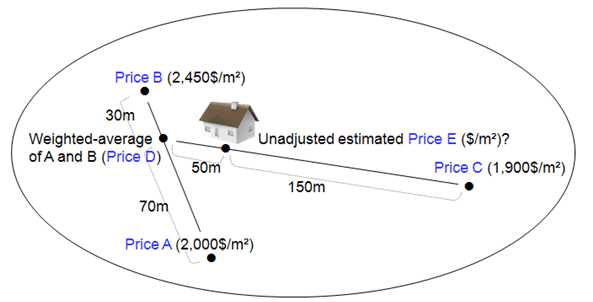The Sales comparison approach is an estimation methodology for valuing real estate. The post details how the sales comparison approach works and presents situations where it should or should not be used.
a. Methodology
The sales comparison approach provides a good estimate of the value of the property when the property to be valued is similar to properties which have been recently sold within the same city, town or village and whose transaction or sales prices are readily available.
In determining the similarity between properties the appraiser would compare a number of factors/ characteristics:
- Real property rights conveyed
- Financing terms
- Condition of sale
- Market condition
- Location
- Physical characteristics
- Economic characteristics
An example of the process followed is given below:

Note: That each property considered must be similar. Further the properties should not be separated by a major street or river as this could possibly impact the prices of the properties.
The unadjusted estimated price of House E is calculated as follows. It should be kept in mind that this price is considered unadjusted because it assumes that House E is homogenous is every way, except exact location, to the other properties from which its price is being derived- therefore the only variation accounted for in the price is location as given by the distances between the properties being considered in the calculation. After this unadjusted price is established it would need to be adjusted to account for property specific differentials between it and the other properties being considered.
The price of property E is a weighted average of the sales prices of similar properties where the weights are the distances of these properties in relation to property E. We consider three recent sales transactions around E, which are for properties A, B and C, which sold for $2000 per square meter, $2450 per square meter and $1900 per square meter respectively.
On a map locate point D. This is the intersection between the straight line connecting properties A and B and the extended straight line that connects properties C and E. The measured distances between the respective points are as follows:
From point A to D it is 70 meters, from point D to B it is 30 meters, D to E is 50 meters and from C to E it is 150 meters.
The unadjusted price of property E is the weighted average price per square meter, found by using the sales prices of properties C and D and their locations in relation to E. As we know there is either no property at D or there has not been any recent sales price for D, so D in turn is the weighted average price per square meter, founding by using the sales prices of properties A and B and their location in relation to D. This process is carried out in the following two stages, first we calculate the weighted average price per square meter at D, and then we calculated the unadjusted weighted average sales price at E:
Price of D = (Price of A * 30 + Price of B * 70)/ (30+70) = (2000*30+2450*70)/(100) = $2,315 per square meter
Price of E = (Price of D * 150 + Price of C * 50)/ (150+50) = (2315*150+1900*50)/(200) = $2,211.25 per square meter
Adjustments to the estimated price of property E are made to account for the real interest involved in that property (i.e. on account of the property’s own characteristics and features) being evaluated as compared to the ones ( A, B, C) used in the estimation process.
b. Appropriate Uses
This approach is usually applied when there are a number of similar properties which have recently been sold or which are currently up for sale.
c. Inappropriate Uses
The sales comparison approach should not be used to value very specialized properties as there are few if any comparative sales price numbers and data that would be readily available on which to base the data analysis and calculation.
We have detailed the Sales comparison approach to collateral valuation of real estate above. In the next post we will look at how real estate is valued using the Income Capitalization Approach.
